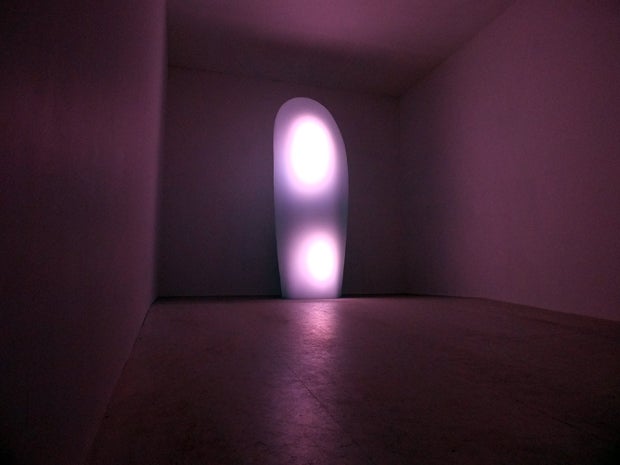Ascending the grand stairs at the Royal Academy’s Burlington Gardens gallery in Mayfair, one first encounters a glowing, globular, molded plastic sculpture that seems to float overhead above the half landing of the stairs. This sculpture is by Japanese born, London educated, New York based artist, Mariko Mori. Faint voices emit from somewhere nearby and echo from the niche on the landing ahead. Like artifacts dropped from another dimension, the sculpture “Birds” and the sound piece “We are here” sit in stark, futuristic difference to the 18th century Italianate architecture of this old London gallery.
Climbing the second set of stairs to the first floor I take a minute to look down over the balustrade onto the sculpture that previously was above me. I see now that “Birds” is hung by four metal cables. The opalescent, tear drop shape, like an apparition, suggests an effortless lightness as if it should be floating without the rickety aid of metal fastenings.
The whispering voices I mentioned before continue, gently chanting, “We are here. We bring you … love,” and other vague mantras soaked in reverb and echo, falling somewhere between spiritualism, new age optimism and a nostalgic sci-fi idea of interstellar life. I can see the speaker now, where before they were mysteriously reverberating within the niche on the landing of the stairs.
I don’t want to know how this was assembled. I want the sculpture to float like a cloud and the voices to surround me, but they don’t. The speaker is mounted to the mezzanine with a metal bracket and the sculpture hangs from four metal cables. I think for a second that Mori might want the same… For the sculpture to float and the voices to surround. But they can’t, we don’t make floating sculptures yet, and we haven’t yet evolved (or created) the ability to send sound telepathically.

Entering the gallery I step onto a walkway that has been built over the original parquet flooring of the building it raises on a slight incline and turns a corner. It creaks underfoot and the utilitarian construction reminds me of airport corridors. Around the corner in a room of its own is a large pebble shaped, colour emitting monolith called “Tom Na H-iu II.” The colours ever so slightly shift hue and dance around inside of the monolith, they “breathe” off and on, like the LED power indicator on a sleeping MacBook. There are three people sat in the room gazing at it, careful not to disrupt the spell or the silence, they seem lost, rapt in meditation. I think briefly of a scene from the 1969 French science fiction film Fantastic Planet where a group of aliens leave their bodies during an unashamedly psychedelic meditation session.
It’s not the only time I think of Fantastic Planet as I wander through the exhibition. There are imaginary technologies in that film that seem to have evolved more by organic processes than created as items of technological manufacture, beaded tiaras, for example, that impart information directly to the brain or floating holographic transmissions with no apparent projection source, as if pure thought could be rendered into a form. Some of Mori’s work also conjures for me this vague sense of unprecedented technologies.
In Mori’s sculpture “Miracle” a multifaceted crystal the size of a large plum hangs above a circular pile of what appear to be large salt crystals and glass bubbles. “Miracle” lists its materials as simply Glass, Crystal, Metal and Salt. Looking at it I imagine that despite their common origin as some base material the components of this structure have been subjected to so many diverse and technologically intricate methods of shaping, cutting and forming they have become some other substance entirely. Listing the materials so simply suggests a kind of technological mystery behind their manufacture as if these were artifacts from some future completely alien to us in its elegance and advancement. They’re not though. The sculpture feels flat, but I’m intrigued by this conflict between the what is intended and what we actually get in front of us.
I’m reminded of something that Blake said in the Proverbs of Hell: “What is now proved was once, only imagin’d.” In Mori’s work I see an imagined future, objects manufactured with technologies that haven’t been invented yet. A rickety draft of future possibilities. It’s failures are slightly endearing, as if what she wanted to create isn’t possible to make yet, floating sculptures, telepathically generated sound, an enlightened, aesthetic society… But the sculptures are suspended with cables, the sound comes from speakers, imaginary mental vistas are rendered in watercolour and computer generated imagery, the most advanced material at her disposal is plastic. But the ideas are lingering there. I’m reminded of an old music video, Lifeforms by Future Sound of London circa ’95. Endearingly clunky early 3D graphics are employed to show us an impossible dream world, bearing all the optimistic promises of technology for eventual transcendence.




